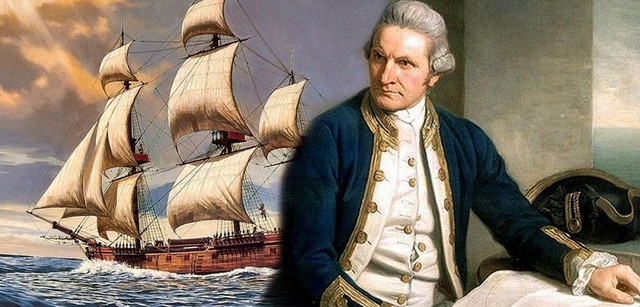The expedition of Captain James Cook
It is strange now to think that in the 18th century Australia and New Zealand were nothing but a rumor for the whole world. Ferdinand Magellan made the first crossing of the Pacific in 1520. There was a suspicion that in the depths of the world there was a vast unknown continent, it was usually called Terra Australis Nondum Cognita. Many European sailors, including Francis Drake, have vainly looked for this mysterious land.
In 1769 the British Admiralty organized a scientific expedition to monitor the movement of Venus. In addition, the expedition had a secret mission to find a hidden continent. Admiralty chose a brilliant young navigator named James Cook, who led the expedition.
Cook was born in a small family in a small village of Marton in Yorkshire. From the age of 17 he began to learn the basics of the seafarer's profession, and at night he studied algebra, geometry, trigonometry, navigation and astronomy. At the end of his apprenticeship he began working on merchant ships on the Baltic Sea. He firmly went to his goal and eventually he was offered the command of a merchant ship. Surprisingly, he refused such a tempting offer, instead he voluntarily went to the Royal Navy as an experienced sailor.
Cook quickly climbed the career ladder. He created valuable maps during the siege of Quebec, which attracted the attention of the British Admiralty. In the early 1760s he explored the uneven coastline of Newfoundland, mastering the skills of practical shooting under the most unfavorable conditions.
His appointment as captain of a major expedition to the South Seas was a remarkable achievement, since very few people ever managed to rise from the sailor to the commander. And, in addition, such high-profile appointments were usually accompanied by bribery and corruption and were provided to those who had influence. Cook chose the type of ship he knew well. He was strong, able to withstand strong storms, could put a lot of provisions and, if necessary, could be controlled by a small team. Cook left Plymouth on August 26, 1768 with a fairly large team of 94 people.
He went around Cape Horn and anchored to Tahiti on April 13, 1769, where observations were to be made on the transit of Venus, but they were not as convincing and accurate as expected. It was an idyllic stay on the island with crew and islanders. Then Endeavor continued on its way to New Zealand, where Cook displayed the entire coastline, making only minor errors, the maps actually used today are practically the same.
On the southeast coast of Australia, Cook stopped in the botanical bay. Here botanists of the expedition collected rich samples. It was here that the Cook team first met the Aboriginal tribe before heading north to the Island of Owning, announcing the entire studied coastline of the British. They returned to England through the Cape of Good Hope July 12, 1771.
Cook was promoted. Now as commander he was authorized by the Royal Society to seek the mythical Terra Australis. His first trip proved that New Zealand was not associated with a larger massif. And although he charted the east coast of Australia, it was not what they were looking for. They were sure that the purpose of their search was much farther to the south. The expedition made a round-the-world voyage on the southern latitude. Cook almost collided with the mainland Antarctica, but turned north back to Tahiti.
The purpose of Cook's third and final voyage was to find the Northwest Passage, which was believed to link the Atlantic and Pacific Oceans. The expedition made stops in South Africa, Tasmania, New Zealand, Tahiti, Canada, Alaska and Hawaii.
Unfortunately, Cook came into confrontation with part of the Hawaiian islanders and was killed on February 14, 1779. His travels paved the way for the British colonization of New Zealand and Australia. His successful shooting and compiled maps strengthened the Royal Navy as a naval superpower of that time.
